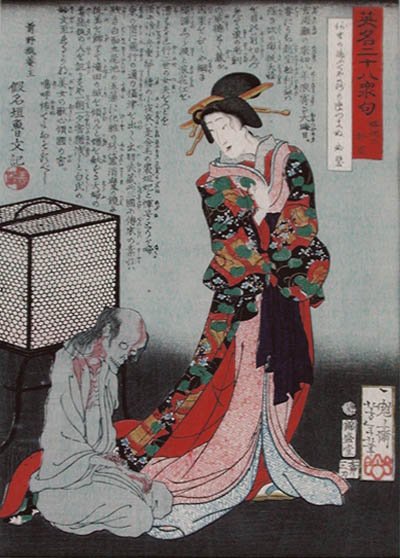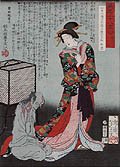| Title: |
Dakki no Ohyaku (Encounter with the Ghost) |
| Artist: |
Yoshitoshi, Tsukioka (Japan, 1839 - 1892) |
| Date: |
1866 |
| Medium: |
Original Japanese Woodcut |
| Publisher: |
Sanoya Tomigoro (Kinseido) |
| Signature: |
Signed Ikkaisai Yoshitoshi hitsu |
| Source: |
Twenty-Eight Murders with Verse (Eimei Nijuhasshuku) |
| Note: |
Tsukioka Yoshitoshi: The undisputed master of Meiji
period art dating between (1868 & 1912), Tsukioka Yoshitoshi's woodcuts are now ranked beside those of Hiroshige,
Hokusai and his former master, Kuniyoshi. Yoshitoshi became a star pupil
of Kuniyoshi at the young age of eleven and, in 1853, designed his first
published woodcut print at age fourteen. Until 1860, Yoshitoshi's art
was influenced by the dominant Utagawa style, but after that date he broke
out into a striking form of artistic expression that was all his own.
Daring colour combinations combined with dramatic and expressive postures
began to lead the way, quickly influencing an entire era of Japanese art.
This is all the more remarkable when one considers that through most of
his life Tsukioka Yoshitoshi was continually afflicted with serious eye disorders
and mental breakdowns. At the time of his death, Yoshitoshi's fame was
so widespread that he had over eighty recorded pupils. Deservedly, Yoshitoshi
is now one of the most sought after of Japanese woodcut artists. |
| |
Twenty-Eight Murders with Verses: The twenty eight Yoshitoshi and Yoshiiku woodcuts from the, Twenty-Eight Murders with Verses, also known as Heroes for the Twenty-eight Lunar Lodges with Poems (Eimei Nijuhasshuku), are perhaps the most notorious works of art in Yoshitoshi's entire oeuvre. The famous Japanese writer, Ryunosuke, once commented that he could not sleep at night after looking at the "Twenty-Eight Murders", and in 1971, Mishima Yukio
based his book, "Banquet of Blood", on these prints. John Stevenson writes that each design from the set "illustrates a killing in stunning, brutal detail. Several show the stabbing or decapitation of people, with bloody hand-prints on robes emphasizing the intimacy of their struggle. Glue mixed with red pigment gives the blood on the prints a congealed verisimilitude." * |
| |
That Yoshitoshi's art was sometimes very violent cannot
be disputed. Other great masters of the woodcut, such as Kuniyoshi and
Hokusai, depicted similar scenes. Violence and horror were simply part
of Japanese life and art. But the greatest masters, such as Tsukioka Yoshitoshi,
used their art to examine the psychological tension produced by violence
or any other extreme emotion. |
| |
Such is the case with Tsukioka Yoshitoshi's, Dakki no Ohyaku, and the encounter with the ghost, a masterpiece from the Twenty-Eight Murders with Verses, also known as, Heroes for the Twenty-eight Lunar Lodges with Poems (Eimei Nijuhasshuku) published in 1866 by Sanoya Tomigoro. In Japanese literature, seductive, but murderous women are often referred to as Dakki (Da ji), 'Wicked Women'. One of the most famous of the Dofuku stories is the Dakki no Ohyaku. This historical narrative tells of the 'Dokufu', the 'Poison-Woman', a name also refereeing to dangerously seductive women who corrupt men. Dakki (Daji), was a famous Geisha who is believed to have been possessed by a malevolent fox spirit, a Yokai from Japanese mythology and folklore. Daji was the favorite consort of King Zhou Xin, who is said to have been extremely malignant, and one of the most corrupt and decadent rulers in Chinese history. Dakki (Daji), is represented in a Kabuki play as Koman, a Geisha who was also called Dakki, and portrayed as a captivating, but wicked woman of ill repute with the power to provoke the downfall of any man. Yoshitoshi's beautifully dressed woman is a striking example of the Japanese 'Da ji', and is typical of Dofuku narratives. Here, she is confronted by a ghost who was obviously murdered by a severe blow to the head, possibly one of her victims. Tsukioka Yoshitoshi brilliantly contrasts the opulent and colourful world of the living woman with the gray and shadowy world of the dead. It is an unforgettable portrayal of crime and retribution. The Museum of Fine Arts, Boston includes an impression of Tsukioka Yoshitoshi's this original woodcut also listed as Dakki no Ohyaku, from the series Eimei Nijuhasshuku in its permanent collection, Accession Number 11.37651. |
| |
Japanese Mythology and Folklore: Supernatural apparitions commonly known in Japan as Yokai, sometimes spelled (Youkai), have been around in Japanese legends for centuries. Stories of the exploits of those worshiped as gods, and the misdeeds of the threatening, dark forces behind the noxious and sinister nature of those thought to be demons have been passed down through legends and folklore, eventually making their way into popular culture. Other words that have a similar meaning as Yokai may include, 'ayakashi, 'mononoke', or mamono', and a common English translation for Yokai is 'monster', but in reality, its meaning encompasses a vast array of mythological phenomenon. According to various superstitions and legends, it is believed yokai have an innate connection to the moon, some youkai are recognized as beneficial, and said to have the power to bestow good fortune and health; while others are presumed evil, dangerous, or just untrustworthy, and capable of frightening, intimidating, or even murdering their victims. Although they are very different in nature and appearance, most Yokai have certain characteristics in common, such as their arrogant attitude towards humans, their mischievous, and impish disposition, mystic powers, and the ability to create pandemonium. Today, Yokai are most often described as unexplained, but powerful apparitions with bewitching, or grotesque features. One of the most common powers attributed to the Yokai is the ability to alter their appearance, transforming or metamorphosing into anything or anyone, a clever trick that could lead to disconcerting or frightful experiences for humans. In Japanese folklore beings that posses this power are known as shape shifters, and changelings (obake, and bakemono). Tsukioka Yoshitoshi's original woodcut, "Encounter with the Ghost", is a striking representation art portraying the supernatural. |
| |
The fox is a Yokai (monster), that goes by various names, 'ninko' (man fox), 'Izumo, Yako' (field fox), and 'Kyushu, Osaki' (split tail), and of course, 'Kitsune' which is the name given to the fox in Japan. The fox is also called a 'Henge' (another name given to mystical creatures that posses the power to transform for good or evil). The kitsune is a free spirits by nature, and as it grows older, it is able to transform into human shapes and assume the characteristics (both the features and personality) of a person (man or woman), or may choose to posses someone's body in order to deceive or influence others, most often, preferring the body of a beautiful woman to bewitch its victims, much like the stories associated with Dakki (Daji), the the favorite Geisha of King Zhou. The Kitsune possesses a diversity of supernatural powers, but only comes in three colors, silver, white, and gold. Legend has it that it becomes more powerful, more intelligent and much wiser with age. By the time this spirit reaches maturity, it can grow up to nine tails, however, only one of those tails is the main source of power. It is said that the secret to destroying this creature is to cut off its tail, but first, you must discover which tail is the source of power. Now, according to Japanese folklore, Kitsune are said to have a life span of about ten thousand years and those that reach maturity are considered to be at the pinnacle of their powers and revered as the wisest and most powerful creatures of their kind. Most importantly, at this stage, they have gained the power of infinitive vision and are often referred to as nine-tailed foxes, a reference mentioned in Yamato Province: Fox (Kitsune) Tadanobu. Although some local traditions categorize Kitsune into the various supernatural powers they represent (Heaven, Void, Spirit, Wind, Fire, Earth, Rivers, Oceans, Mountains, Forests, Thunder, Time and Sound), they are generally split into two classifications, the first being the Yako or Nogitsune (a mischievous and sometimes malevolent fox), and the second is the Zenko (a benevolent and virtuous fox associated with the Shinto deity, Inari, one of the 'Seven Good Luck Gods'). It is also believed the fox is the Messenger for the Inari / Oinari, the deity of rice (a symbol for earth's fertility and the nourishment of life). Traditionally, a pair of foxes were supposed to guard the Inari / Oinari in order to protect the livelihood of the nation's farmers and people. The Japanese also believed the fox could help them ward off evil Kimon (ominous or evil direction). Due to their ability to control and influence humans, most folk tales recommend that kitsune be feared, respected, mistrusted and should only be approached with caution. |
| Reference: |
* (John Stevenson, Yoshitoshi's One Hundred Aspects of the Moon,
San Francisco Graphics Society, Redmond, Washington State, 1992, pp. 17
& 18. ) |
| Size: |
Oban (Sizes in inches are approximate,
height preceding width of plate-mark or image.) |
| |
Framed and Matted with 100% Archival Materials |
| |
View larger Framed Image |
| |
 |
| Condition: |
This original woodcut is printed upon 19th century Japanese mulberry (rice) paper and with full margins as published in 1866 by Sanoya Tomigoro. It is a brilliant early impression bearing wood grain indicative of an initial printing
and with vibrant, unfaded colours. It is in near excellent condition throughout. Dakki no Ohyaku, Eimei Nijuhasshuku (Encounter with the Ghost, from the 'Twenty-Eight Murders with Verses') represents a superb example of the famous art of Tsukioka Yoshitoshi. |
| Price: |
Sold - The price is no longer available. |
| Important Information: |
The artist biographies, research and or information pertaining to all the original works of art posted on our pages has been written and designed by Greg & Connie Peters exclusively for our site, (www.artoftheprint.com). Please visit us regularly to view the latest artworks offered for sale. We will soon be posting an update of our most recent research and include the biographical and historical information pertaining to our next collection of original works of art created by artists throughout the centuries. We hope you found the information you were looking for and that it has been beneficial.
Our Gallery, (Art of the Print / www.artoftheprint.com) guarantees the authenticity of every work of art we sell 100%. Full documentation and certification is provided. We offer a wide selection of international fine art dating from the early Renaissance to the contemporary art period. |










![]()
![]() or
phone Greg & Connie (905) 957-6666
or
phone Greg & Connie (905) 957-6666